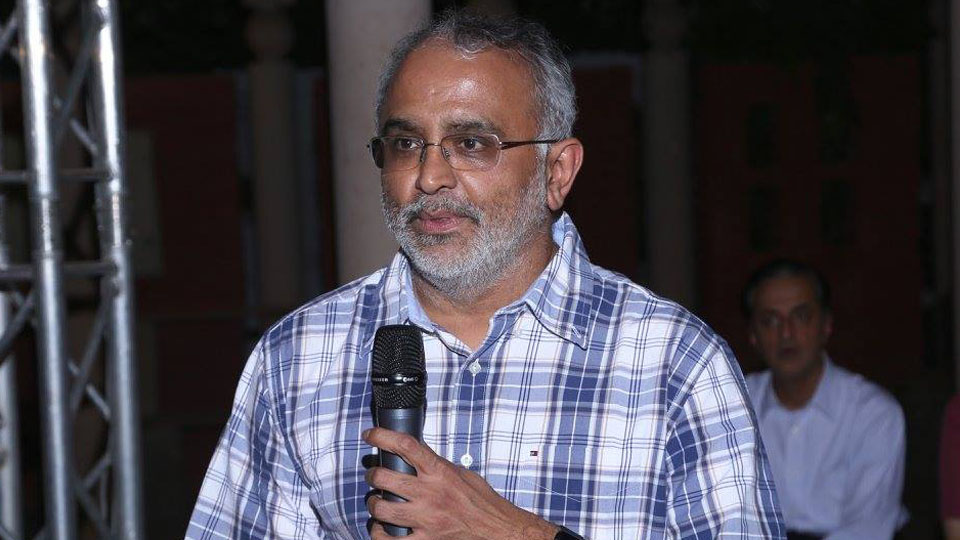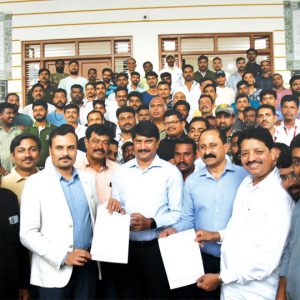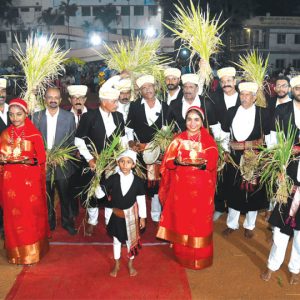By Krishna Prasad, Senior Journalist
Mysuru-based senior journalist Krishna Prasad, former Group Editorial Officer, ‘The Hindu’ and former Editor-in-Chief, ‘Outlook,’ delivered H.Y. Sharada Prasad Birth Centenary Commemorative Talk on the topic ‘Journalism in the time of fake news, propaganda & mass delusion’ at Ganabharathi in Kuvempunagar on Apr. 21, 2024.
‘Star of Mysore’ is publishing the excerpts of Krishna Prasad’s talk in continuation of the article ‘All about fake news you always wanted to know but hesitated to ask’ written by Dr. Shalini R. Urs, Founder-Chairperson, MYRA School of Business, Mysuru and published in ‘SOM’ dated July 30. Excerpts:
Although the term “fake news” is on everybody’s lips these days, it is by no means new. It has been around for a long time. The term “noble falsehood” goes as far back as 380 BC to Athens in Greece. In Plato’s Republic, the “noble falsehood” is proposed by Socrates and refers to any myth or fiction that binds a society or nation together.
In 17th century Paris, there was this version of fake news: the “canard” which were broadsides printed with an engraving. Remember Marie Antoinette, the French Queen who famously said: “If they can’t have bread, let them eat cake?” During the French Revolution, the engravers inserted the face of Marie Antoinette in one canard. Historians believe that this intentionally fake political propaganda against Marie Antoinette contributed to the pathological hatred of the queen, leading to her execution.
The production of fake, semi-false and true but comprising snippets of news reached a peak in 18th century England, when newspapers began to circulate among a broad public.
In fact, a Christian Priest founded a newspaper called The Morning Post, which supplied paragraph upon paragraph of news snippets, much of it fake. In 1784, it ran a paragraph about a gigolo serving Marie Antoinette. The gold-standard in this genre of fake news was set by The Iron-Plated Gazetteer in London, which reported a classic one-sentence paragraph and then published an aside:
This fake news outlet would often print a footnote to its scandalous items, which read: “Half of this article is true.” It was left to the reader to decide which half.
Fake news is not new as a phenomenon. So, how would a soft, understated Mysurean like Sharada Prasad battle the new demon?
[Holenarasipur Yoganarasimham Sharada Prasad was a freedom fighter, civil servant, journalist and Media Advisor to three former Prime Ministers — Indira Gandhi, Morarji Desai and Rajiv Gandhi].
Sharada Prasad himself recounted an incident from 1970s which bordered on what might be labelled fake news today:
“There was a European media woman with a formidable reputation as an interviewer who wanted to meet Mrs. Gandhi soon after the Emergency (1975) had been declared. She had interviewed her earlier. But this time around, Mrs. Gandhi was not keen to be interviewed for obvious reasons. The lady went ahead, nevertheless, and concocted answers to a set of questions. By way of providing colour and authenticity, she described how she and Mrs. Gandhi walked hand in hand down the stately staircase of South Block. And there, at the entrance of the building was a beggar and a convenient cow which dropped its dung on the beggar as if on cue the moment the Prime Minister appeared. And our correspondent added dramatically: ‘Indira Gandhi muttered, “This is democracy” and I felt her fingers dig into the palm of my hand’.”
Sharada Prasad does not tell us how the Indira Gandhi Government hit back at the celebrity interviewer.
However, what this incident reveals to us — as indeed several others in its long history do — is that there was something sanguine about fake news in the past. They were gossipy, scurrilous, titillating, yes, but mostly harmless and certainly not evil, devious or dangerous.
But, the fake news scourge democracies are dealing with today is entirely different in its methods, magnitude and motives. Today you have entire Government Departments and political organisations dedicated to the task of fabricating and disseminating lies on an industrial scale.
Unlike a few hundred or a few thousand people receiving fake news in a small geographical area in the past, you have entire cities, countries and continents which are susceptible, with large masses of people instantly receiving it on their phones and digital devices.
Unlike the prurient tastes of a few citizens being quenched by a paragraph of fake news on a sexual peccadillo, you now have deadly real-world consequences: bigotry, hatred, lynchings, killings, wars, ostracism, ethnic and religious genocide.
And, unlike just a few peddlers with the resources to publish fake news, you now have hundreds of millions of people with the power to spread the misinformation and disinformation to every corner of the globe straight from their pockets and at almost no cost.
Never have democracies faced a bigger challenge to distinguish right from wrong, good from bad, fact from fiction and truth from lie.
What enables this is technology, usually owned by big corporations, and usually available in abundance to the highest bidder. And what facilitates this are the user-friendly platforms whose algorithms — unlike the “noble falsehood” of ancient Greece which was aimed at keeping society together — are designed to incite and divide.
Which is why, when Jair Bolsanaro — a divisive, misogynistic, homophobic, anti-minority, anti-migrant, pro-business, climate change denier — entered the office of President of Brazil in 2019, the crowds were not cheering him, his party or his running mate. Instead, they were shouting, “Facebook, Facebook, Facebook,” and “WhatsApp, WhatsApp, WhatsApp”. Reason: It was his online campaign on those platforms, funded by that country’s conservative business lobby, which endlessly forwarded and re-forwarded his bile and propaganda that had put him in power.
This is called “computational propaganda” and its impact on democracies is now an established fact in a number of democracies: Britain, Germany and India that is Bharat.
Just two Indian examples will suffice. The first example is from Mirza Muzaffarnagar, Uttar Pradesh. In August 2013, a year before the 2014 general elections. It resulted in Hindu-Muslim clashes. Over 50 people died and over 40,000 people fled their homes.
This is a textbook case of the dastardly directions that fake news can take. In truth, the video that was shared was not from Muzaffarnagar. It was from faraway Afghanistan. But the skilful editing of the video was enough to set the Jat belt on fire.
The second example is from all over India. Between January 2017 and May 2018, at least 39 people were killed across the country in incidents of mob lynchings. This was spurred by rumours that child-lifters were on the prowl. In every incident, a video of the abductors at work in that village or town was put to use.
No longer do the State and the media elites have a monopoly on public opinion. Now everyone has the power to be their own Murdoch, Churchill or Goebbels.
Little wonder, then, that the World Economic Forum’s 2024 Global Risk Report says India faces the highest risk of misinformation and disinformation this year.
So, in this avalanche of fake news and propaganda, what can journalism do when all the bullets in the revolver — government, political parties, giant corporations, technology platforms, a hypnotised citizenry — are loaded against it?
The primary task of credible news media today is fact-checking. Every statement, every claim, every boast, every promise, every assurance needs to be filtered, evaluated and weighed before being published or aired. The days of journalists acting as the servile stenographers to power and their mindless couriers to the masses, is over.
Every reporter, every editor has to be a fact-checker of every story if our democracy is not to disintegrate and die under the weight of plain white lies.
Prof. Jason Stanley of Yale University, who has written landmark books on fascism and propaganda, describes propaganda thus: “The language of democratic ideals takes on corrupted opposite meanings. Corrupt politicians run anti-corruption campaigns; freedom of speech claims are used to suppress speech.” On all the big talking points today, national, regional or local, the media needs to employ the same critical lens instead of mindlessly amplifying lies.
The media scholar George Brock spells out the role for journalism more precisely in his book, Out of Print – Newspapers, Journalism and the Business of News in the Digital Age:
“Journalism is the systematic attempt to establish the truth of what matters to society in time for that information to be useful. The activities that define journalism still matter even if the context in which they are done has changed. There are four core tasks that journalism should perform, which can be better done by people trained and experienced in this work. The four tasks are: verification, sense-making, witness and investigation. These are the irreducible core of what can be distinguished as journalism and they are the basis of the trust on which it relies.”
Sharada Prasad, the Media Advisor, would heartily agree: we journalists must check, cross-check and double-check. Sharada Prasad got the timeline wrong. The European journalist was not writing about an encounter with Indira Gandhi after the Emergency, but well before, three years before.
Why a punctilious man like Sharada Prasad would get the details of such a story wrong is not for us to guess, but this is precisely what we journalists need to do, in everything we do, when lies are being spun at a frightening scale: check, crosscheck, double-check.
As Nicholas Kristof of The New York Times says, “We (journalists) should be in the lighting business, not the heating business.” But you should not leave this onerous task to us journalists alone. You, and I mean each one of you, as a media consumer must demand more from your newspapers, news channels and news websites.
If your media vehicle is merely reporting “live” what this politician or that is saying, if it does not cross-check every claim at every level, if it does not provide context and clarity, it is serving you poorly in these challenging times. It is serving some other master, not you the reader and viewer. Just having a small corner for “fact-checking” is no longer sufficient.
The deleterious impact of fabricated news and relentless propaganda is most visible in WhatsApp groups. Family groups, army officers groups, music appreciation groups, alumni association groups, none are spared from its horrors. Seemingly reasonable adults are being supplied the daily fodder to delude themselves and delude others, and to run down those who disagree with their stunted view of the world. So, what can you as a responsible citizen do to stop the tide?
In Kannur, Kerala, government schools from class VIII to class XII have a daily class on how to detect fake news. The lesson that the children learn — “Check it first. Check it yourself. Do not forward recklessly” — is one that every adult in this room can imbibe. Merely because something appeared on a website which somebody forwarded to you does not make it true.
Caught in the maelstrom, journalists have become the object of much abuse and derision today, both at the hands of news-makers and news-consumers. This is mostly for partisan reasons. In a deeply polarised India, for most citizens who wear their ideology on their sleeve, newspapers and news channels and news websites are no more than a device to validate their own view of the world.
When their view and that of their media vehicle concur, there is praise and acceptance. When the two clash, there is ridicule and rejection. But as the great Gabriel Garcia Marquez, who proudly called himself a journalist even after winning the Nobel Prize for Literature, said 70 years ago: “Journalism is a biological necessity of humanity.” He called journalism as “the world’s best profession.” Like it or leave it, you need journalism.








Recent Comments